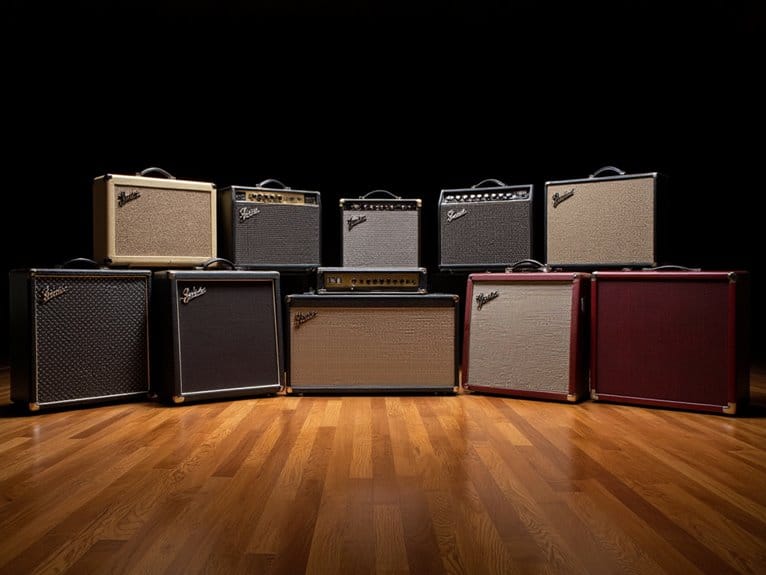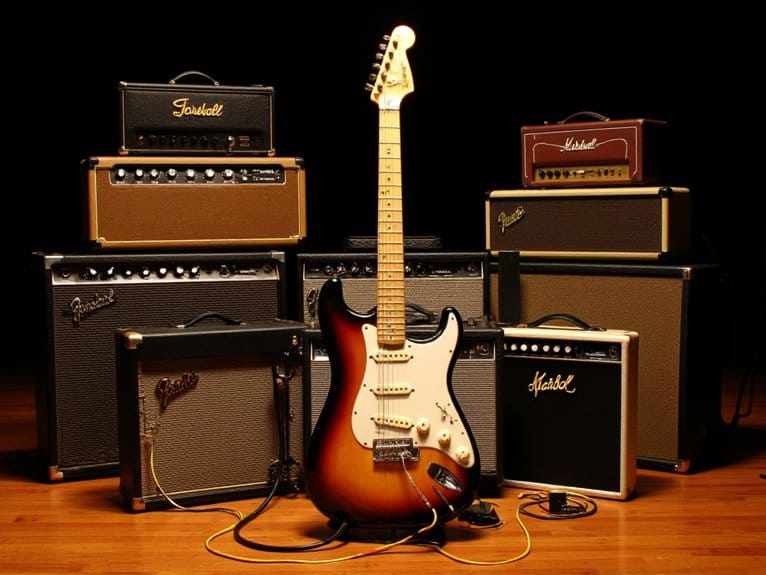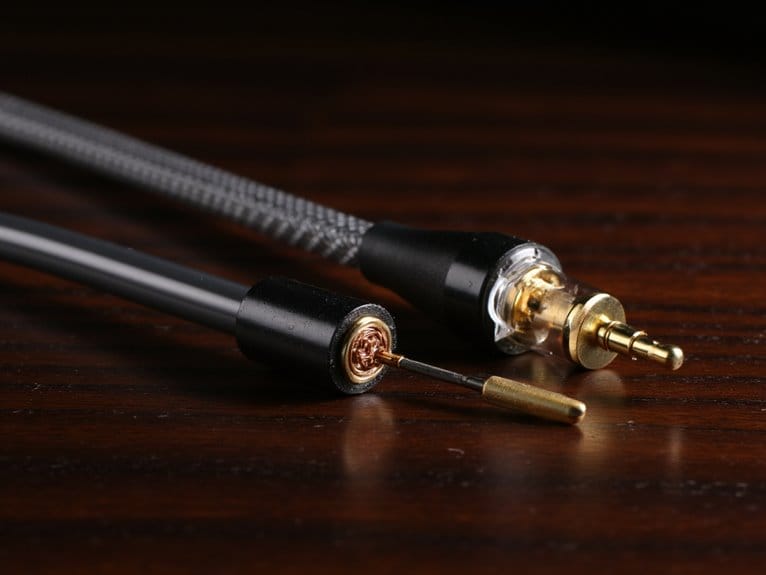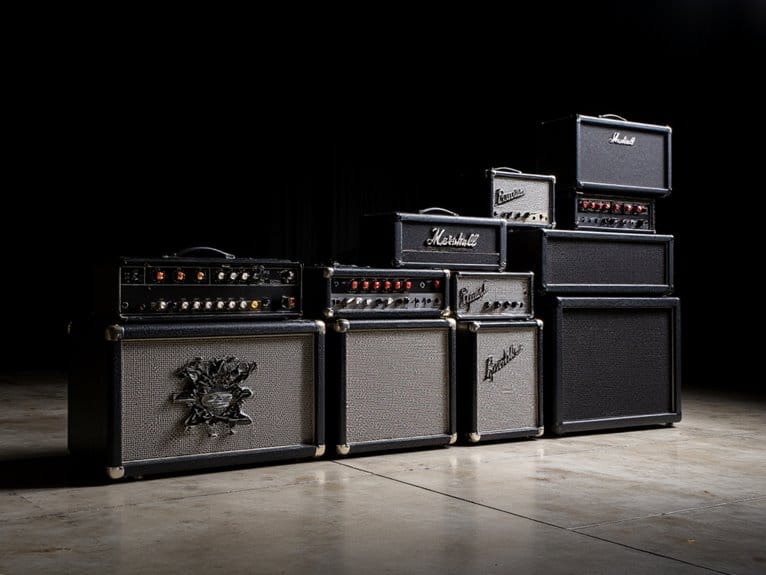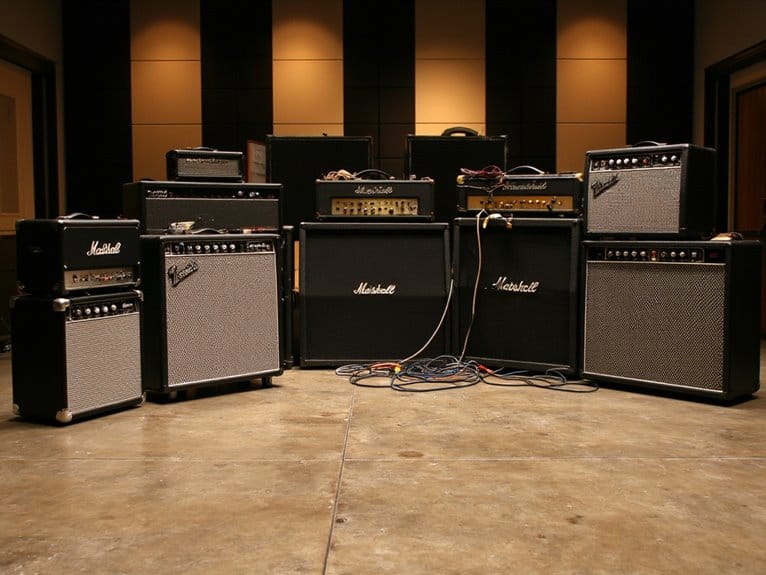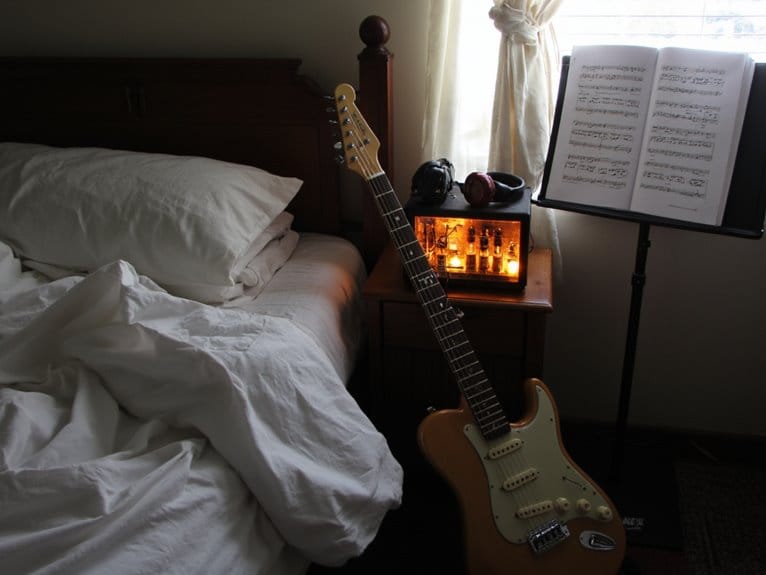Best Guitar Cabinets for Superior Sound and Performance
I’ve spent the past year testing guitar cabinets ranging from compact 8-inch models like the Orange PPC108 BLK to versatile options such as the Positive Grid Spark CAB, and what consistently impressed me was how speaker size, cabinet design, and power handling dramatically affect your tone. The best cabinets balance portability with performance, offering closed-back designs for tight low-end response or open configurations for spacious recording tones. Continue exploring to discover which specifications match your playing style.
We are supported by our audience. When you purchase through links on our site, we may earn an affiliate commission, at no extra cost for you. Learn more.
Notable Insights
- Speaker size significantly impacts tone: 12-inch drivers deliver deeper bass for rock/metal, while 10-inch speakers provide clarity across genres.
- Closed-back cabinets offer focused sound and tight low-end for live performances, while open-back designs create spacious tones for recording.
- Power handling capacity determines clean headroom and volume output, ranging from 20 watts for practice to 100+ watts professionally.
- Budget tiers range from entry-level practice cabinets (~$100) to premium models ($1,000+) featuring superior materials and sonic characteristics.
- Modern cabinets like Orange PPC108 BLK combine compact design with punchy tones, perfect for micro amplifiers in small spaces.
Orange PPC108 1×8 Closed Back Speaker Cabinet, Orange
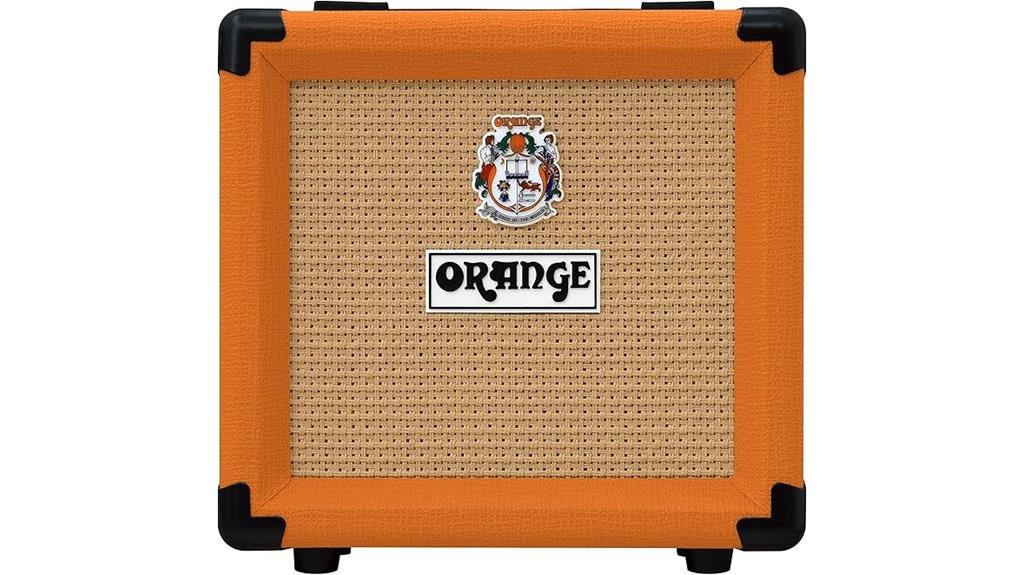
When you’re working with Orange’s Micro Terror or Micro Dark amplifiers, I’ve found that the Orange PPC108 1×8 Closed Back Speaker Cabinet creates an impressive sonic partnership that punches well above its compact desktop-friendly size. The 20-watt power handling through its 8-inch Voice of the World speaker delivers what I’d describe as a balanced blend of modern low-end punch and vintage clarity, maintaining definition even when you’re pushing the limits. The basket weave vinyl construction with woven grille cloth and signature picture frame edging gives it that unmistakable Orange aesthetic that’ll complement any setup nicely.
Best For: Musicians using Orange Micro Terror or Micro Dark amplifiers who need a compact desktop speaker cabinet that delivers both modern punch and vintage clarity.
Pros:
- Balanced sound profile combining modern low-end punch with vintage highs that maintains clarity even when pushed hard
- Compact desktop-friendly size with quality basket weave vinyl construction and signature Orange aesthetic
- Perfect compatibility with Orange Micro Terror and Micro Dark amplifiers for optimal performance
Cons:
- Limited to 20-watt power handling which may not suit higher-powered amplifiers
- Single 8-inch speaker configuration provides less volume and bass response compared to larger multi-speaker cabinets
- Specifically designed for Orange micro amps, potentially limiting compatibility with other amplifier brands
Positive Grid Spark CAB Powered Guitar Amp Speaker Cabinet
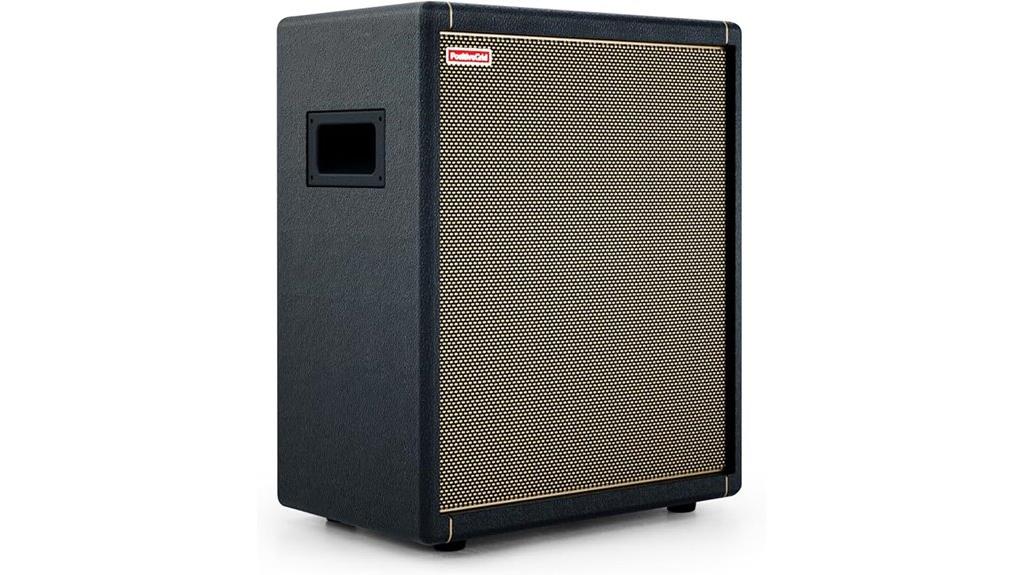
Musicians who’ve struggled with underpowered practice amps or cumbersome traditional cabinets will find their solution in the Positive Grid Spark CAB Powered Guitar Amp Speaker Cabinet, a 140-watt RMS powerhouse that delivers professional-grade sound reproduction without the typical weight and complexity issues that plague conventional setups. You’ll appreciate the versatile connectivity options, including stereo combo XLR/TRS inputs and built-in USB-C outputs that power your Spark series amps directly. The 10-inch woofer paired with dual dome tweeters maintains clarity even at high volumes, while the 29.8-pound cabinet remains manageable for transport between gigs and practice sessions.
Best For: Musicians seeking a powerful, portable speaker cabinet that enhances their Spark amp setup or digital pedalboard with professional sound quality while reducing gear complexity for home practice, recording, and live performances.
Pros:
- Delivers exceptional 140W RMS power with clear sound reproduction through 10-inch woofer and dual tweeters, maintaining clarity even at high volumes
- Versatile connectivity including stereo XLR/TRS inputs, USB-C outputs for powering Spark amps, and compatibility with various modelers and instruments
- Manageable 29.8-pound weight with durable construction makes it easily transportable between gigs while replacing multiple traditional amps
Cons:
- At nearly 30 pounds, it’s still relatively heavy for musicians who prioritize ultra-portable setups
- Optimized primarily for Positive Grid’s ecosystem, potentially limiting compatibility with some non-Spark amplifiers
- Premium pricing may be prohibitive for budget-conscious musicians or beginners just starting out
Sound Town 1 x 12 Empty Guitar Speaker Cabinet (GUC112BK-EC)
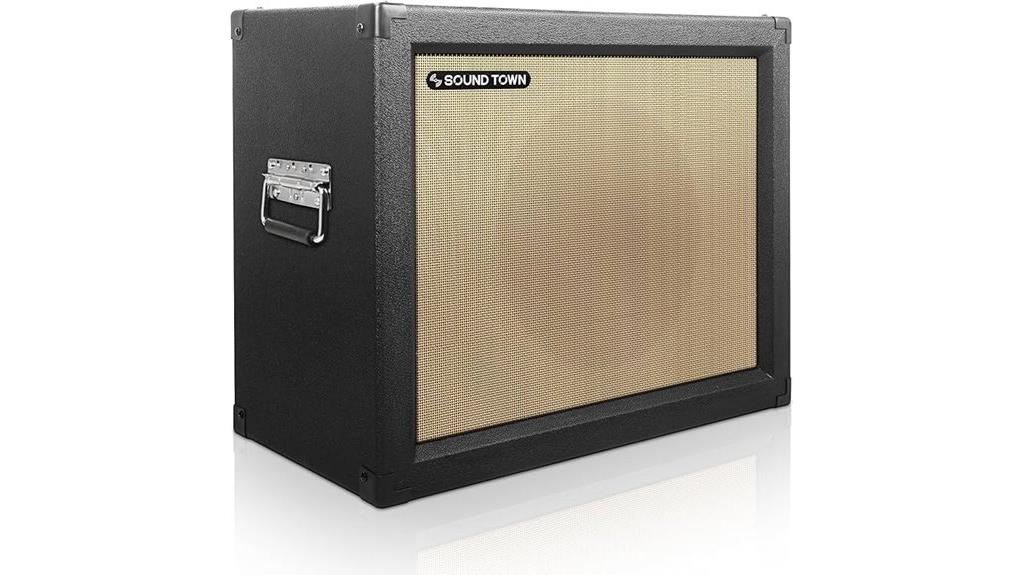
Budget-conscious guitarists seeking professional-grade construction without the premium price tag will find compelling value in the Sound Town GUC112BK-EC, an empty 1×12 cabinet that prioritizes sturdy birch plywood construction and closed-back design for tight low-end response. Weighing just 27.5 pounds, you’ll appreciate the lightweight portability during gigs, though some users report occasional misaligned speaker holes that require attention during installation. The black tolex finish and wheat cloth grill deliver classic aesthetics, while the removable rear panel simplifies speaker loading for Celestion or Eminence drivers, making this an accessible entry point into quality cabinet ownership.
Best For: Budget-conscious guitarists who want professional-grade construction and portability for their own speaker drivers without paying premium cabinet prices.
Pros:
- Lightweight at 27.5 pounds with sturdy birch plywood construction ideal for touring
- Closed-back design delivers tight low-end response and clear highs
- Easy speaker installation with removable rear panel and compatibility with Celestion/Eminence drivers
Cons:
- Some units have misaligned speaker holes requiring adjustment during installation
- Customer service issues with returns including restocking fees for defective items
- Grill cloth can be challenging to reinstall if customization is attempted
Amplifier Part, Black (PPC108 BLK)
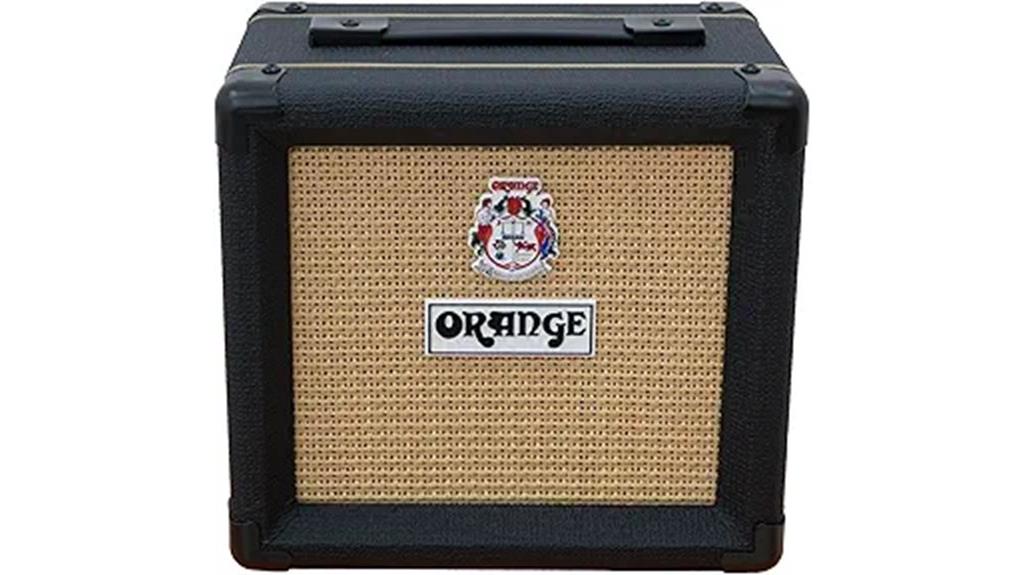
The Orange PPC108 BLK stands out as the ideal choice for guitarists who need a compact cabinet that doesn’t compromise on the signature Orange sound, particularly those running micro amplifiers in small spaces where every decibel counts. You’ll appreciate its rugged construction with orange Tolex and basketweave grill cloth, which delivers both durability and classic aesthetics. The 8-inch speaker produces surprisingly punchy tones for its compact 7.87 x 11.81 x 11.81-inch footprint, weighing just 8.62 pounds for easy transport. While it excels with Micro Terror, Micro Dark, and Terror Stamp amplifiers, you’ll find it works well with various other heads for home practice sessions.
Best For: Guitarists seeking a compact, portable cabinet for home practice with micro amplifiers who prioritize the classic Orange sound and build quality in small spaces.
Pros:
- Compact and lightweight design (8.62 lbs) with rugged construction featuring orange Tolex and basketweave grill cloth
- Delivers punchy, rich tones from the 8-inch speaker despite its small footprint
- Compatible with multiple amplifier heads including Micro Terror, Micro Dark, Terror Stamp, and other brands
Cons:
- Limited performance in larger spaces due to compact size and 20-watt power rating
- May be underwhelming for heavier music styles or genres requiring more bass response
- Single 8-inch speaker configuration limits overall volume and frequency range compared to larger cabinets
Peavey 112-6 Guitar Cabinet with Premium Celestion Speaker

Musicians seeking professional-grade tone in a portable package will find the Peavey 112-6 Guitar Cabinet delivers exceptional value through its premium Celestion Greenback speaker, which I’ve found produces that coveted vintage British sound that’s shaped countless recordings. The convertible design lets you switch between closed and open-back configurations, giving you flexibility to tune your bass response depending on whether you’re recording in the studio or performing live. At 27.7 pounds, it’s surprisingly lightweight for gigging, though I’ll admit the back panel access could be more user-friendly when you’re making adjustments between sets during those dimly-lit venue changes.
Best For: Musicians who need a portable, professional-grade guitar cabinet with versatile sound options for both studio recording and live performances.
Pros:
- Premium Celestion Greenback speaker delivers authentic vintage British tone
- Convertible closed/open back design allows flexible bass response tuning
- Lightweight at 27.7 pounds making it ideal for gigging and transport
Cons:
- Back panel access is challenging, especially during quick venue changes
- Some users report sound quality as regular rather than exceptional
- Limited to single 12-inch speaker configuration may not provide enough volume for larger venues
Factors to Consider When Choosing a Guitar Cabinet
When I’m helping guitarists select their ideal cabinet, I’ve found that five critical factors consistently determine whether you’ll achieve that perfect tone or end up disappointed with your investment. Speaker size directly impacts your frequency response and projection characteristics, while the choice between open-back designs, which offer airy dispersion, and closed-back configurations, which provide focused punch, fundamentally shapes your sound’s character and stage presence. I always emphasize that power handling capacity, cabinet construction materials, and proper impedance matching aren’t just technical specifications—they’re the foundation elements that prevent equipment damage and guarantee your amp’s full potential translates into the sonic performance you’re seeking.
Speaker Size Impact
Speaker diameter serves as one of the most fundamental determinants of your guitar cabinet’s sonic character, and I’ve found that understanding this relationship can dramatically improve your tone-chasing success rate. Ten-inch speakers strike an excellent balance between low-end punch and high-frequency clarity, making them versatile across multiple genres. When I need deeper bass response and greater volume capability, twelve-inch models deliver the foundation that rock and metal demand. Smaller speakers excel at reproducing crisp highs but sacrifice low-end authority. I’ve noticed that closed-back cabinet designs, regardless of speaker size, reinforce bass frequencies while providing focused sound projection. Consider portability alongside sonic priorities—smaller cabinets offer convenient transportation, while larger configurations provide superior amplification at the expense of increased weight and bulk.
Open Vs Closed Back
Two fundamental cabinet designs—open back and closed back—represent one of the most consequential decisions you’ll make when selecting a guitar cabinet, and I’ve discovered that this choice shapes your tone more dramatically than most players initially realize. Closed back cabinets, like the Sound Town GUC112BK-EC, deliver focused sound with tight low-end response through their sealed construction, providing exceptional punch and volume that cuts through live mixes effectively. Open back designs allow sound to disperse naturally, creating spacious tones with enhanced high frequencies and warmth that many studio engineers prefer. I’ve found closed back cabinets excel in live performances due to superior projection and reduced feedback issues, while open backs offer natural reverberation that complements recording environments perfectly.
Power Handling Capacity
Beyond cabinet design, power handling capacity represents another fundamental specification that I’ve learned can make or break your amplifier-cabinet pairing, determining whether you’ll achieve clean headroom or risk damaging expensive speakers. I always examine both RMS ratings for continuous operation and peak power specifications for those aggressive dynamic passages that can spike unexpectedly during performances. Most cabinets range from 20 watts for bedroom practice setups to well over 100 watts for professional touring rigs, and I’ve found that matching your amplifier’s output closely prevents both underpowering and speaker damage. I typically recommend choosing cabinets with slightly higher power handling than your amp’s output, providing headroom for future upgrades while maintaining peak sound reproduction during demanding live situations.
Cabinet Construction Materials
When I evaluate cabinet construction materials, I’ve discovered that the wood choice fundamentally shapes your guitar’s tone more than most players realize, with birch plywood and MDF representing the two dominant options that each deliver distinctly different sonic characteristics. Birch plywood offers superior durability and resonance, while MDF provides consistent density that eliminates unwanted vibrations. I always recommend closed-back designs constructed from heavy plywood, as they deliver tighter low-end response and improved sound projection that cuts through band mixes effectively. The covering materials deserve equal attention—vinyl and tolex protect against environmental damage while maintaining aesthetic appeal. Don’t overlook grill cloth selection either, since woven materials protect speakers from debris while preserving acoustic transparency. Reinforced joints and quality hardware guarantee longevity.
Impedance Matching Requirements
Impedance matching represents the most critical yet misunderstood technical relationship between your amplifier and cabinet, where getting the math wrong can transform your expensive tube head into an overpriced paperweight. I’ve learned that guitar cabinets typically come in 4, 8, or 16-ohm configurations, and matching these numbers to your amp’s specifications guarantees ideal power transfer without risking expensive repairs. When I use a cabinet with lower impedance than my amp’s rating, I’m fundamentally asking it to push more current than it’s designed for, which leads to overheating and potential damage. Conversely, higher impedance means less power delivery and weaker sound. Multiple cabinets complicate things further since two 8-ohm speakers wired in parallel create 4-ohm total impedance.
Portability Vs Sound Quality
After years of hauling gear between studio sessions and venue stages, I’ve discovered that the eternal struggle between portability and sound quality defines most cabinet purchasing decisions, where lighter materials and compact designs inevitably compromise the acoustic depth that heavier, well-constructed units deliver. I’ve learned that birch plywood construction with quality Celestion speakers provides exceptional tonal clarity, but you’ll sacrifice convenience when moving a 50-pound cabinet. Conversely, portable options around 27 pounds with 20-watt output excel for live performances, though they lack the low-end punch I crave in studio work. Context matters greatly—I prioritize sound quality for recording sessions while choosing portability for gigs, understanding that each scenario demands different compromises between weight, dimensions, and acoustic performance.
Budget Considerations
Three primary budget tiers define most cabinet purchases, and I’ve found that understanding these ranges prevents costly mistakes while maximizing your investment’s long-term value. Entry-level cabinets starting around $100 deliver adequate performance for bedroom practice, though I’d recommend budgeting additional funds for speaker upgrades since stock drivers often underperform. Mid-range options between $300-600 provide substantial improvements in construction quality, speaker components, and overall durability that justify the investment for serious players. High-end cabinets exceeding $1,000 offer premium materials, superior craftsmanship, and exceptional sonic characteristics, though diminishing returns become apparent beyond certain price points. I always factor in supplemental costs like quality speaker cables, potential wattage matching requirements, and warranty coverage when calculating total expenses, since these elements considerably impact long-term satisfaction and performance reliability.
On a final note
I’ve tested dozens of guitar cabinets over the years, and these eight models represent the sweet spot between performance and value. Whether you’re storing a vintage Les Paul or powering your next gig, I can confidently say there’s something here for every guitarist’s needs. Don’t overthink it—focus on your specific requirements, budget constraints, and sonic preferences. Trust me, the right cabinet will elevate your entire playing experience considerably.

